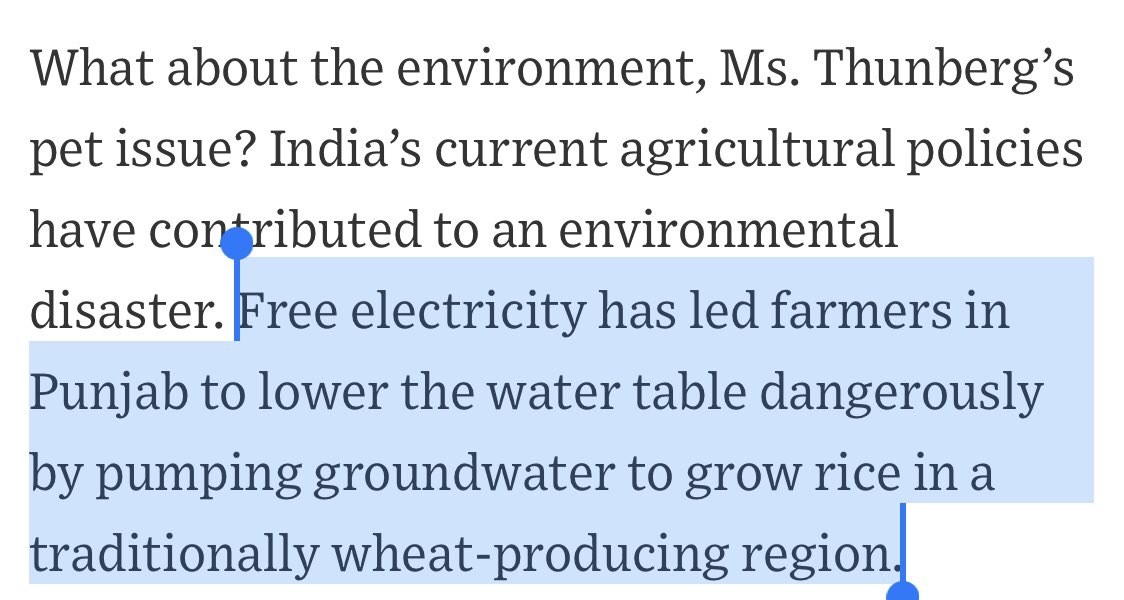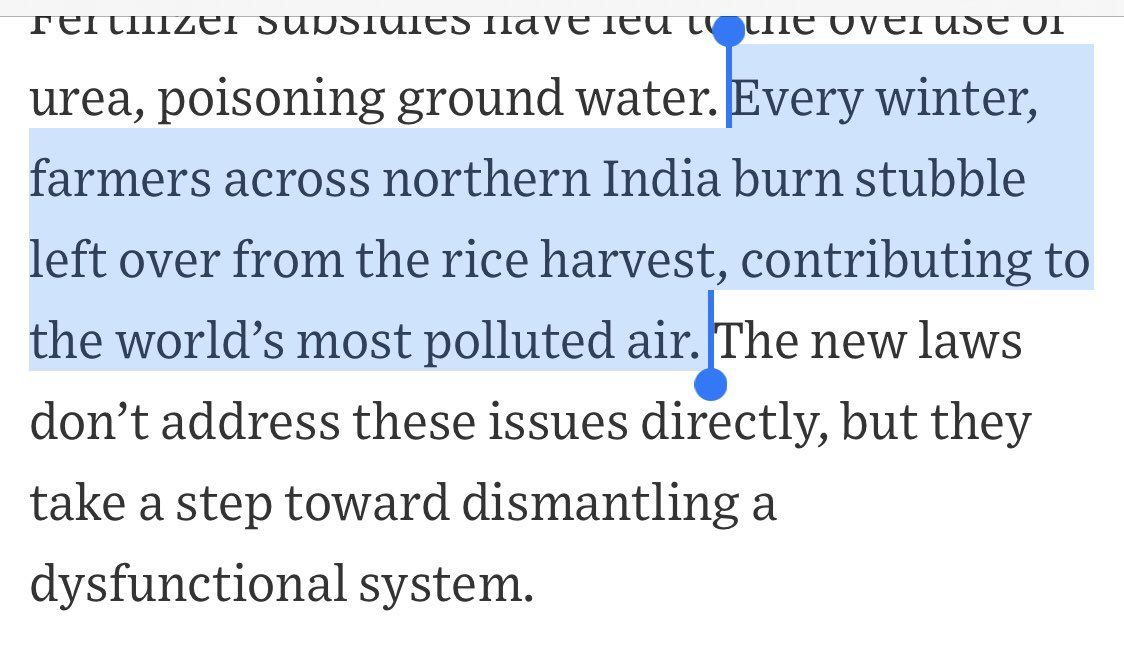I’m going to do a slightly substantial thread in Sadanand Dhume’s piece for @WSJ because I am quite disturbed at the flex the debate is taking. The problems in the piece go far beyond a debate on how “gentle” the govt has been on the farmers. Thread. 

This causation is misrepresented. There’s a history to this. During the Green Revolution Punjab and Haryana moved to the wheat-paddy cultivation cycle from their traditional crops. This was encouraged and as we all know from CBSE textbooks, was done in the national interest.
At that time sustainability wasn’t a watchword but by 1980 a massive decline in the water table was noted. Why? Because paddy required five times more irrigation than wheat. So if you irrigate a wheat crop six times in one season, paddy will require 30 irrigations.
When free electricity was thrown in the mix farmers’ preferences changed. They also started growing longer term maturing paddy, like Pusa 44. Paddy was also planted in May-June with a maturation in October.
Dhume’s piece seems to suggest that paddy cultivation is preferred.
Dhume’s piece seems to suggest that paddy cultivation is preferred.
This is incorrect. After the paddy crop is harvested, the areas are brought under wheat cultivation if the farmer has the means to.
Why is this even important? Because of TIMING. This also brings me to the second issue I have with the piece. Stubble burning.
Why is this even important? Because of TIMING. This also brings me to the second issue I have with the piece. Stubble burning.
In the piece, wheat-paddy is presented as an either/or scenario. It’s actually both. Previously between crops, farmers could even throw in a potato crop. However, things took a dramatic turn when overuse of the groundwater rang alarm bells. So what happened?
In an effort to protect the water table, the Punjab Preservation of Subsoil Water Act was enacted in 2009. Started in Punjab, it was emulated in Haryana almost word for word. This act notified dates for sowing to basically structure farming in such a way that
the transplanting of paddy from nursery to field could coincide with the monsoon. So nursery planting could begin on May 15, and transplants could happen on June 15. Now, this kinda screwed up the cycle. How?
Harvest time was pushed to late October. This meant that to get to the wheat planting date of Nov 15, farmers had to sprint to clear the field of stubble. Labor costs to clear were heavy. Easiest thing to do? Fire it all up, i.e., stubble burning.
So one environmental solution exacerbated another environmental crisis. My issue with the piece is these are not unlinked events, as the piece presents. They’re linked and straight up to the policy level.
Certainly there has been a MSP regime that has guaranteed income for farmers making it difficult to diversify. And certainly free electricity can be connected to a lowering of the groundwater. But we need to understand these nuances and set the context correctly.
Now I’ll get to the idea in the piece that only a small section of farmers are protesting these laws. I think this is a function of local level organizational capacity. Certainly not all protesting farmers have be reached Delhi. But there have been protests in other places.
Here’s a piece on Gujarat https://www.google.com/amp/s/m.thewire.in/article/agriculture/gujarat-narendra-modi-farmers-laws-protests/amp
Another protest in Guj https://www.newsclick.in/we-know-modi-well-cannot-fool-Us-gujarat-farmers?amp
Why should West Bengal be behind? https://www.google.com/amp/s/www.newsclick.in/West-Bengal-Farmers-Line-Protest-Programmes-Across-Districts%3famp
Bihar had a protest as well https://www.google.com/amp/s/www.newsclick.in/bihar-successful-human-chain-farmers-gear-up-chakka-jam-february-6%3famp
MP farmers wouldn’t be left behind https://www.google.com/amp/s/www.hindustantimes.com/india-news/farmers-protest-live-updates/story-KfDN1fQytvP2MQht7MkK8H_amp.html
Southern states Andhra, Telangana and Karnataka have also registered protest.
There’s actually a rather long list of protests but suffice it to say that my point here is that it is in error to suggest that the farm protests are being done by minority of Debbie Downers who are getting in the way of their own, and other farmers’, progress.
Now let’s get to the violent confrontation. First of all, there’s an article in The Tribune which explains the inside politics of the farmers protests. It’s a good one and is confirmed by the folks I have generally chatted with on the ground. https://m.tribuneindia.com/news/nation/how-extremist-elements-hijacked-farmers-rally%C2%A0and-deep-sidhus-role-in-chaos-203993
In a nutshell, the group of farmers that went towards the Red Fort is a breakaway faction with its own agenda which the main movement had tried to sideline. Frontman for this, Deep Sidhu, has also previously been on a BJP campaign for actor Sunny Deol.
I think this particular angle should have been mentioned because the farmers movement, while forged in solidarity, DOES have its own internal dynamics. If you’re writing for people with no background knowledge of these local details, then it’s even more important to point it out.
The piece sort of cements over the split-in-the-movement issue and presents all the farmers as riotous.
There’s one more thing. It’s the language. The piece says “tens of thousands stormed into the capital”. No that’s not accurate. They had permission for a protest given by authorities. Even so they encountered a darned container blocking their path.
Then he says “celebrity Twitter activism is based on a reductive caricature of complex issues as a faceoff between colorfully turbaned sons of the soil and a thuggish government backed by evil corporations.”
Literally no one in their right mind has said anything about turban colors. That’s just a weirdly orientalist thing to say.
The piece also unquestioningly takes the state’s version of the tractor incident where Navreet Singh was killed. There are two versions. The state’s version where the death was caused by the tractor ramming into a barricade. And then there’s the other version.
The point is, the other version is credible too. It should at least be mentioned. Caravan has a piece on this as well.
Why do I think the alternative version should be mentioned. Because it should. It’s journalism. If there are more than one narratives, you state both before
Why do I think the alternative version should be mentioned. Because it should. It’s journalism. If there are more than one narratives, you state both before
Making an value judgment on either.
I’ll grant the piece some leeway for at least confirming that folks on the human rights flex aren’t all wrong. However then we get to that odd description of “relatively gentle”. And this is what I think.
I’ve learned over the course of a decade studying conflict NEVER EVER
I’ve learned over the course of a decade studying conflict NEVER EVER
to compare the lived experiences of trauma of any two people or groups. It’s always tempting to order things on a linear scale from 0 to 10, just got clarity but it doesn’t work.
Because when we do so we essentially end up scoring violence and the violence at the lower end of the score scale, seems to become “acceptable”. That’s the problem with that line.
When is violence ever gentle?
Thanks!
When is violence ever gentle?
Thanks!


 Read on Twitter
Read on Twitter



